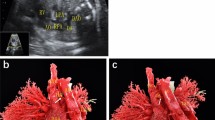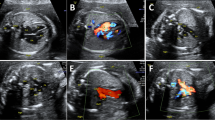Summary
Accurate prenatal diagnosis of complex congenital cardiovascular anomalies, vascular ones in particular, is still challenging. A fetal cardiovascular cast model can provide a copy of the cardiac chambers and great vessels with normal or pathological structures. This study was aimed to demonstrate three-dimensional anatomy of complex congenital cardiovascular anomalies in fetuses by means of corrosion casting. Twenty fetuses with prenatal-ultrasound-diagnosed complex cardiovascular anomalies were enrolled in this study (19 to 35 gestational weeks). Fetal cardiovascular cast models were made by a corrosion casting technique. The specimens were injected with casting material via the umbilical vein, and then immersed in strong acid after casting fluid was solidified, to disclose the geometries of cardiovascular cavities. Nineteen cast models were successfully made from 20 specimens. The casts distinctly showed the morphological malformations and spatial relationship between cardiac chambers and great vessels. One hundred and eleven abnormalities were revealed by casting in the 19 specimens, including 34 abnormalities located in the cardiac chambers (3, 4 and 27 anomalies in the atria, atrioventricular valves and ventricles, respectively), and 77 in the great vessels (28, 20, 24 and 5 anomalies in the aorta and its branches, the pulmonary artery, the ductus arteriosus and the major veins, respectively). Corrosion casting can display three-dimensional anatomy of fetal complex cardiovascular anomalies. This improves our understanding of related pathomorphology and prenatal diagnosis.
Similar content being viewed by others
References
Cook AC, Yates RW, Anderson RH. Normal and abnormal fetal cardiac anatomy. Prenat Diagn, 2004,24(13):1032–1048
Gittenberger-de Groot AC, Bartelings MM, Poelmann RE, et al. Embryology of the heart and its impact on understanding fetal and neonatal heart disease. Semin Fetal Neonatal Med, 2013,18(5):237–244
Jenkins KJ, Correa A, Feinstein JA, et al. Noninherited risk factors and congenital cardiovascular defects: current knowledge: a scientific statement from the American Heart Association Council on Cardiovascular Disease in the Young: endorsed by the American Academy of Pediatrics. Circulation, 2007,115(23):2995–3014
Mone F, Walsh C, Mulcahy C, et al. Prenatal detection of structural cardiac defects and presence of associated anomalies: a retrospective observational study of 1262 fetal echocardiograms. Prenat Diagn, 2015,35(6):577–582
Zhang Y, Xu L, Qiu J, et al. Association between SNP rs10569304 on the second expressed region of hole gene and the congenital heart disease. J Huazhong Univ Sci Technolog Med Sci, 2010,30(4):430–436
Clur SA, van Brussel PM, Ottenkamp J, et al. Prenatal diagnosis of cardiac defects: accuracy and benefit. Prenat Diagn, 2012,32(5):450–455
Holland BJ, Myers JA, Woods CR. Prenatal diagnosis of critical congenital heart disease reduces risk of death from cardiovascular compromise prior to planned neonatal cardiac surgery: a meta-analysis. Ultrasound Obstet Gynecol, 2015,45(6):631–638
Alves Rocha L, Araujo Junior E, Rolo LC, et al. Screening of congenital heart disease in the second trimester of pregnancy: current knowledge and new perspectives to the clinical practice. Cardiol Young, 2014,24(3):388–396
Yates RS. The influence of prenatal diagnosis on postnatal outcome in patients with structural congenital heart disease. Prenat Diagn, 2004,4(13):1143–1149
Berkley EM, Goens MB, Karr S, et al. Utility of fetal echocardiography in postnatal management of infants with prenatally diagnosed congenital heart disease. Prenat Diagn, 2009,29(7):654–658
Gilboa SM, Salemi JL, Nembhard WN, et al. Mortality resulting from congenital heart disease among children and adults in the United States, 1999 to 2006. Circulation, 2010,122(22):2254–2263
Lorentziadis M, Chamogeorgakis T, Toumpoulis IK, et al. Topographic anatomy of bronchial arteries in the pig: a corrosion cast study. J Anat, 2005,207(4):427–432
Eytan O, Har-Toov J, Almog R, et al. Feto-feto-fetal transfusion syndrome in monozygotic monochorionic triamniotic triplets: vascular evaluation by a cast model. Placenta, 2005,26(5):432–436
Toro K, Kiss M, Szarvas V, et al. Post mortem introduction of corrosion cast method after coronary stent implantation. Forensic Sci Int, 2007,171(2-3): 208–211
Liu J, Chen DF, Chen WY, et al. Clinical anatomy related to the hepatic veins for right lobe living donor liver transplantation. Clin Anat, 2013,26(4):476–485
Zheng N, Gong J, Yu SB, et al. A combination method for preparing casting and transparent liver specimen. Clin Anat, 2010,23(5):559–562
Cook AC, Fagg NL, Allan LD. Use of casts in the necropsy diagnosis of fetal congenital heart disease. Br Heart J, 1992,68(5):481–484
Han W, Xie M, Cheng TO, et al. The vital role the ductus arteriosus plays in the fetal diagnosis of congenital heart disease: Evaluation by fetal echocardiography in combination with an innovative cardiovascular cast technology. Int J Cardiol, 2016,202: 90–96
Wang Y, Cao HY, Xie MX, et al. Cardiovascular cast model fabrication and casting effectiveness evaluation in fetus with severe congenital heart disease or normal heart. J Huazhong Univ Sci Technolog Med Sci, 2016,36(2):259–264
Tegnander E, Williams W, Johansen OJ, et al. Prenatal detection of heart defects in a non-selected population of 30,149 fetuses—detection rates and outcome. Ultrasound Obstet Gynecol, 2006,27(3):252–265
Friedman AM, Phoon CK, Fishman S, et al. The utility of fetal echocardiography after an unremarkable anatomy scan. Obstet Gynecol, 2011,118(4):921–927
Pinto NM, Keenan HT, Minich LL, et al. Barriers to prenatal detection of congenital heart disease: a population-based study. Ultrasound Obstet Gynecol, 2012,40(4):418–425
van Velzen CL, Clur SA, Rijlaarsdam ME, et al. Prenatal diagnosis of congenital heart defects: accuracy and discrepancies in a multi-center cohort. Ultrasound Obstet Gynecol, 2016,47(5):616–622
Deng J, Brookes JA, Gardener JE, et al. Three-dimensional magnetic resonance imaging of the postmortem fetal heart. Fetal Diagn Ther, 1996,11(6):417–421
Hutchinson JC, Arthurs OJ, Ashworth MT, et al. Clinical utility of postmortem microcomputed tomography of the fetal heart: diagnostic imaging vs. macroscopic dissection. Ultrasound Obstet Gynecol, 2016,47(1):58–64
Gindes L, Matsui H, Achiron R, et al. Comparison of ex-vivo high-resolution episcopic microscopy with in-vivo four-dimensional high-resolution transvaginal sonography of the first-trimester fetal heart. Ultrasound Obstet Gynecol, 2012,39(2):196–202
Deng J, Rodeck CH. Current applications of fetal cardiac imaging technology. Curr Opin Obstet Gynecol, 2006,18(2):177–184
Brookes JA, Deng J, Wilkinson ID, et al. Three-dimensional imaging of the postmortem fetus by MRI: early experience. Fetal Diagn Ther, 1999,14(3):166–171
Tutschek B. Simple virtual reality display of fetal volume ultrasound. Ultrasound Obstet Gynecol, 2008,32(7):906–909
Chang CP. Analysis of the patterning of cardiac outflow tract and great arteries with angiography and vascular casting. Methods Mol Biol, 2012,843:21–28
Razon Y, Berant M, Fogelman R, et al. Prenatal diagnosis and outcome of right aortic arch without significant intracardiac anomaly. J Am Soc Echocardiogr, 2014,27(12):1352–1358
Xiong Y, Gan HJ, Liu T, et al. Prenatal diagnosis of crossed pulmonary arteries. Ultrasound Obstet Gynecol, 2010,36(6):776–777
Chaoui R, Schneider MB, Kalache KD. Right aortic arch with vascular ring and aberrant left subclavian artery: prenatal diagnosis assisted by three-dimensional power Doppler ultrasound. Ultrasound Obstet Gynecol, 2003,22(6):661–663
Espinoza J, Goncalves LF, Lee W, et al. A novel method to improve prenatal diagnosis of abnormal systemic venous connections using three-and four-dimensional ultrasonography and’ inversion mode’. Ultrasound Obstet Gynecol, 2005,25(5):428–434
Acknowledgments
The authors are grateful to Weiping LI for his technological guidance for casting fabrication. We express our gratitude to the families who donated their stillborn fetuses for the advancement of medicine.
Author information
Authors and Affiliations
Corresponding authors
Additional information
This project was supported by grants from the National Natural Science Foundation of China (No. 81530056 and No. 81501494) and Hubei Province Health and Family Planning Scientific Research Project (No. WJ2015MB016).
Rights and permissions
About this article
Cite this article
Cao, Hy., Wang, Y., Hong, L. et al. Morphological features of complex congenital cardiovascular anomalies in fetuses: as evaluated by cast models. J. Huazhong Univ. Sci. Technol. [Med. Sci.] 37, 596–604 (2017). https://doi.org/10.1007/s11596-017-1778-9
Received:
Revised:
Published:
Issue Date:
DOI: https://doi.org/10.1007/s11596-017-1778-9




